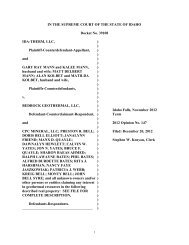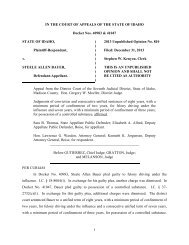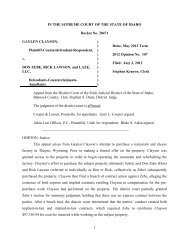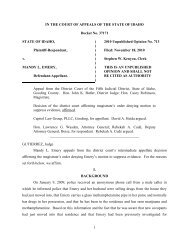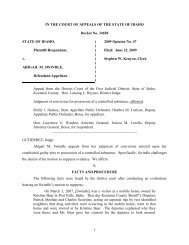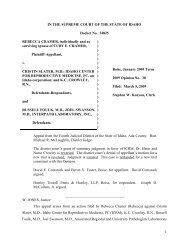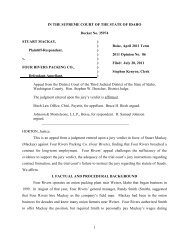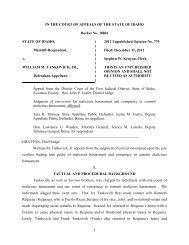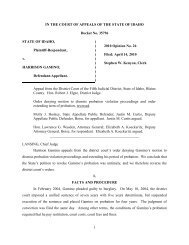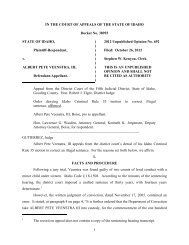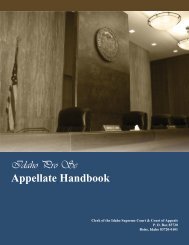April 1, 2013 State v. Hector B. Almaraz, Jr. - Idaho State Judiciary
April 1, 2013 State v. Hector B. Almaraz, Jr. - Idaho State Judiciary
April 1, 2013 State v. Hector B. Almaraz, Jr. - Idaho State Judiciary
You also want an ePaper? Increase the reach of your titles
YUMPU automatically turns print PDFs into web optimized ePapers that Google loves.
testimony may have been improperly admitted. The court stated “[a]nd I have noted to counsel<br />
since then that that was – I didn’t say it on record, but that wasn’t something that should have<br />
been allowed, but it was something in context to something else.”<br />
1. <strong>Almaraz</strong>’s Claims Were Properly Preserved for Appellate Review.<br />
On appeal, the defense argues that the description of <strong>Almaraz</strong> in a shooter’s crouch<br />
improperly invaded the province of the jury because it answered the ultimate issue in the case –<br />
who shot Gabriel Flores? The defense further contends that Lieutenant Steele’s testimony was<br />
improper lay opinion testimony under I.R.E. 701 because it was based on specialized knowledge<br />
and a proper foundation had not been laid for her to testify as an expert. The <strong>State</strong> argues that<br />
<strong>Almaraz</strong> did not properly preserve the issue for appellate review because the defense made no<br />
reference to I.R.E. 701 as grounds for the objection at trial.<br />
Generally, this Court will not consider an alleged error on appeal unless a<br />
timely objection to the alleged error was made at trial. For an objection to be<br />
preserved for appellate review, either the specific ground for the objection must<br />
be clearly stated, or the basis of the objection must be apparent from the context.<br />
<strong>State</strong> v. Sheahan, 139 <strong>Idaho</strong> 267, 277, 77 P.3d 956, 966 (2003) (internal citations omitted).<br />
However, some discretion lies with the court to consider the objection in light of the<br />
context in which it was presented. Under I.R.E. 103(a), an objection must state “the specific<br />
ground of objection, if the specific ground was not apparent from the context.” After reviewing<br />
the objection within the context of the arguments contained in the transcripts, this Court finds<br />
that the issue was properly preserved for appeal. After Lieutenant Steele characterized<br />
<strong>Almaraz</strong>’s stance as “what I call a shooter’s crouch,” the defense objected by stating: “everybody<br />
can look at the same video with the same eyes. And ultimately, it’s the jury’s question. And<br />
interpretation’s out of line.” Moreover, as Lieutenant Steele continued to describe her<br />
interpretations of the video, she testified that the man in the shooter’s crouch moved after Flores<br />
was shot and pointed out his new position on the video. The defense objected stating “that is an<br />
opinion and reasonable people watching this, I guarantee you, will disagree with that<br />
interpretation.” Although the rule was not specifically invoked, the defense’s arguments<br />
surrounding Lieutenant Steele’s testimony show that the defense was concerned that her<br />
conclusion was a lay opinion that was not helpful to a clear understanding for the jury and was<br />
based on specialized knowledge as a police officer in violation of I.R.E. 701.<br />
2. The District Court Did Not Abuse Its Discretion by Allowing Lieutenant Steele to<br />
Testify that <strong>Almaraz</strong> Was in What She Called a “Shooter’s Crouch.”<br />
22



